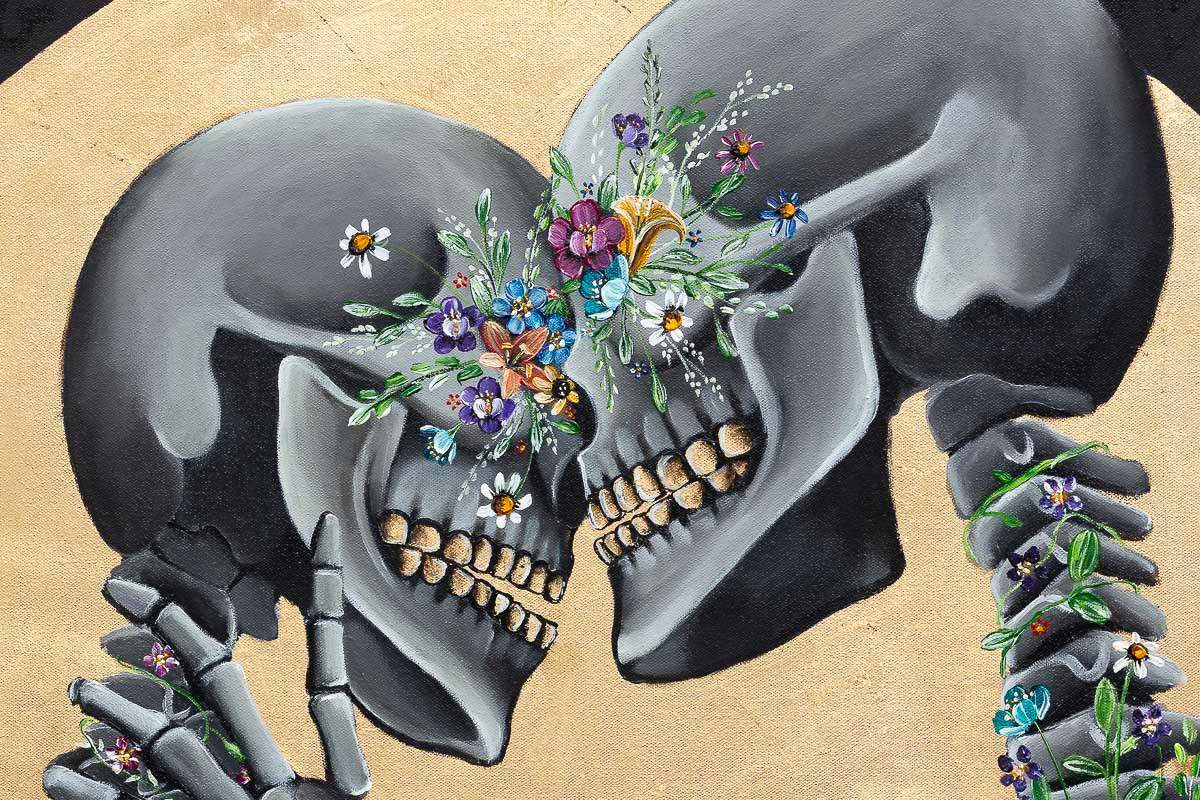Celebrating water, air, foliage and sun: the pristine abstract panels of Kate Taylor are beautiful jewel-like artworks either singly - as the focal point of an interior - or collectively, in one of her trademark tessellating displays. Sometimes revealing authentic birch wood grain; at others demonstrating rich impasto or deep resin lacquer, Taylor's works grace the homes of collectors worldwide.
In our exclusive interview, we welcome Kate Taylor as she tells of her inspirations and technique. A fascinating study of an artists who draws inspiration from nature and travel - and indeed paints on the go!
Celebrating water, air, foliage and sun: the pristine abstract panels of Kate Taylor are beautiful jewel-like artworks either singly - as the focal point of an interior - or collectively, in one of her trademark tessellating displays. Sometimes revealing authentic birch wood grain; at others demonstrating rich impasto or deep resin lacquer, Taylor's works grace the homes of collectors worldwide.
In our exclusive interview, we welcome Kate Taylor as she tells of her inspirations and technique. A fascinating study of an artists who draws inspiration from nature and travel - and indeed paints on the go!
“
Because my work is inspired by nature and the joy that you feel when really present in nature, I loved the idea of incorporating the natural woodgrain into the final pieces.
- Kate Taylor
What was the inspiration to make your box-canvases out of Birch?
It started out being practical…I was resining my pieces and as they became larger, the canvas would sag. It took a while to figure out how to use the panel – I work with a palette knife so the hard knife on the hard surface took some getting used to. Once I started to really see the panels, I fell in love with the woodgrain of the Baltic Birch. I have my panels made for me so that they have really interesting and clean wood grain but, surprisingly, it is still unpredictable in terms of the level of saturation of colour and, therefore, how dramatic the grain is. Once I finish staining the wood (takes about 4-5 very thin coats to build up the colour and not obliterate the woodgrain), I step back and figure out what I want to cover and what I want to retain. This often inspires the composition. I love this idea or unpredictability…how will the stain cover, what does the wood look like, how will the composition and the background play together…..
You’ve used nude wood as well as resin coated pieces, how do you pick which finish to go with? And which is your favourite?
For me, this has to do with the level of energy in a piece. The pieces that are not resined seem a bit more calm and tranquil whereas the resined pieces seem to have a higher level of energy. I often resin pieces that are turquoise and blue – I like the idea of capturing the essence of the water – in the colour and also in the reflections. Honestly, I have a love/hate relationship with resin – I love the super saturated colour and the contemporary look; I feel like it captures the viewer and makes them a part of the piece but it is not easy to work with. It is a stern taskmaster….everything needs to be measured and timed very precisely to ensure it is almost perfect every time. Because I work very intuitively, I often say I have to take off my artist’s hat and put on my scientist hat when I do the resin. My favourite? It seems to be the piece I just finished – resin or not!
“
The palette knife.. I knew without a doubt that I had found my calling. I sent all my brushes to my sister (also an artist) and never looked back.
- Kate Taylor
The palette knife is a time-honoured instrument, used with great effect by artists from Van Gogh to Picasso: what drew you to its use in your own work - what are the advantages to you as an artist?
I can honestly say that I just happened upon the palette knife. I had been painting realism – mostly flowers in bright colours but didn’t really ‘feel’ it. I attended a fun paint afternoon with the mother of a friend and she put the knife in my hand (and a glass of wine in the other) and said “create”. I still get goosebumps when I remember how I stepped back and looked at that very first abstract piece and had an epiphany. What I love about the knife is that you can’t get too tight and fussy. I am very influenced by the Canadian Automatists who worked very intuitively – trying to capture the emotion and energy of something vs an accurate and representational view. I mix my colours on the knife to ensure each ‘petal’ or ‘fish’ is interesting in its own right but, other than that, I want the work to stay loose and inspirational. I find that when I think to hard or try and consciously direct the work, it loses something in the process.
“
I am a risk taker; a huge fan of change and putting myself in situations that are challenging….travel forces that. I think it makes you more aware and less likely to get complacent. Hopefully that comes through in my work.
- Kate Taylor
Does travel influence your work?
Absolutely! I am living to the mantra #TravelForArt…where do I want to travel and how do I get there with my art practice! I think travel is good for everyone – to experience how other people think, their opinions, they art and culture. As I have travelled (China, France, Italy, the US and the UK last year), I came to realize that different cities have their own colour palette: now I try and capture that !
Painting while travelling is a challenge as I can’t really carry birch panels with me where I go. I have a small watercolour kit I bring with me. It was so cool to sit painting on our balcony as our boat sailed down the Yangtze River. I am not a good watercolourist but was trying to capture the colour, lines and movement of the places. My tip? You can’t take your studio with you. Take the opportunity to break out of your comfort zone and try something new. It just might lead your work in a new and exciting direction. That said, I do bring my studio to the cottage in Northern Ontario where I paint as much as possible during the summer. I have an outdoor space and I look over a stunning spring-fed lake and hardwood forest that I find incredibly inspiring.
You have related but very distinct different collections, such as Tranquillity and Energy and Motion – what are the characteristics between these styles, and how do they relate to one another?
Actually these used to be in the same collection – Energy and Motion – but abut 2 years ago, I separated them as each started to take on its own personality. Tranquillity is 100% inspired by Monet’s waterlilies and I try and capture the peace and quiet of the water – a lake, a shoreline, flowers by the river etc. For this collection, I use the side of the palette knife and ‘worry’ the paint into lines. Energy and Motion is usually more dramatic with big fat ‘petals’ that are multicoloured. I like to work in 4 different collections at the same time, depends on my mood and keeps it fresh for me. Essentially, all the Collections are about capturing the joy in nature - sometimes it is a quiet joy and sometimes an exuberant joy!
Your work can be hung in any orientation, therefore signed and titled on the reverse, and many collectors create formations/displays of different sizes, shapes and colours. Was this the original intention or something that’s happened organically?
I have always liked the idea of having the final owner of the piece being a part of the creative process – the pieces read differently depending on how you hang them. I work flat and move around the piece as I am creating so truly don’t have an ‘up’ so I started signing only the back. Then, some smart people would say “aha! But you signed on this side so it must be the top”. No, I was just being lazy. Now I sign all 4 sides to eliminate any reference of how it is hung.
Although they stand alone, I always visualized them in a grouping of different colours and sizes…creeping up the staircase. A gallery here in Toronto hung about 25 pieces as a wall art collage and a collector (incidentally from England), bought all of them for their condo wall – created such an impact! I also have new collectors that buy a piece at every show and gradually build up their collection. It is great to see these people a few times a year and hear how they are committed to filling their world with real art!
Once these conditions are met: the works are painstakingly recorded in our state-of-the-art database system (including advanced location tracking) and extensively photographed by Lucy and the image processing team. With extensive ‘macro’ detail shots utilising the Canon EOS 5DS camera: these shots not only form the basis for internet and print promotions: but form a visual record of the work at ultra-high resolution.
Finally; the works that aren’t immediately selected for the gallery walls (or better still, immediately dispatched to a lucky collector) are archived in our temperature controlled ‘vault’. Stored upright, fully surrounded in custom high-impact expanded rubber: the securely stored paintings are routinely checked and rotated onto gallery displays to ensure they remain in mint condition.

















